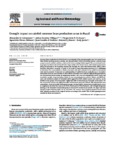Please use this identifier to cite or link to this item:
http://www.alice.cnptia.embrapa.br/alice/handle/doc/1046621Full metadata record
| DC Field | Value | Language |
|---|---|---|
| dc.contributor.author | HEINEMANN, A. B. | pt_BR |
| dc.contributor.author | RAMIREZ-VILLEGAS, J. | pt_BR |
| dc.contributor.author | SOUZA, T. L. P. O. | pt_BR |
| dc.contributor.author | DIDONET, A. D. | pt_BR |
| dc.contributor.author | DI STEFANO, J. G. | pt_BR |
| dc.contributor.author | BOOTE, K. J. | pt_BR |
| dc.contributor.author | JARVIS, A. | pt_BR |
| dc.date.accessioned | 2016-06-08T11:11:11Z | pt_BR |
| dc.date.available | 2016-06-08T11:11:11Z | pt_BR |
| dc.date.created | 2016-06-08 | pt_BR |
| dc.date.issued | 2016 | pt_BR |
| dc.identifier.citation | Agricultural and Forest Meteorology, Amsterdam, v. 225, p. 57-74, Sept. 2016. | pt_BR |
| dc.identifier.uri | http://www.alice.cnptia.embrapa.br/alice/handle/doc/1046621 | pt_BR |
| dc.description | Common bean production in Goiás, Brazil is concentrated in the same geographic area, but spread acrossthree distinct growing seasons, namely, wet, dry and winter. In the wet and dry seasons, common beansare grown under rainfed conditions, whereas the winter sowing is fully irrigated. The conventional breed-ing program performs all varietal selection stages solely in the winter season, with rainfed environmentsbeing incorporated in the breeding scheme only through the multi environment trials (METs) wherebasically only yield is recorded. As yield is the result of many interacting processes, it is challengingto determine the events (abiotic or biotic) associated with yield reduction in the rainfed environments(wet and dry seasons). To improve our understanding of rainfed dry bean production so as to produceinformation that can assist breeders in their efforts to develop stress-tolerant, high-yielding germplasm,we characterized environments by integrating weather, soil, crop and management factors using cropsimulation models. Crop simulations based on two commonly grown cultivars (Pérola and BRS Radi-ante) and statistical analyses of simulated yield suggest that both rainfed seasons, wet and dry, can bedivided in two groups of environments: highly favorable environment and favorable environment. Forthe wet and dry seasons, the highly favorable environment represents 44% and 58% of production area,respectively. Across all rainfed environment groups, terminal and/or reproductive drought stress occursin roughly one fourth of the seasons (23.9% for Pérola and 24.7% for Radiante), with drought being mostlimiting in the favorable environment group in the dry TPE. Based on our results, we argue that eventhough drought-tailoring might not be warranted, the common bean breeding program should adapttheir selection practices to the range of stresses occurring in the rainfed TPEs to select genotypes moresuitable for these environments. | pt_BR |
| dc.language.iso | eng | eng |
| dc.rights | openAccess | eng |
| dc.subject | Environment classification | pt_BR |
| dc.subject | Melhoramento genético | pt_BR |
| dc.title | Drought impact on rainfed common bean production areas in Brazil. | pt_BR |
| dc.type | Artigo de periódico | pt_BR |
| dc.date.updated | 2017-03-07T11:11:11Z | pt_BR |
| dc.subject.thesagro | Feijão | pt_BR |
| dc.subject.thesagro | Phaseolus vulgaris | pt_BR |
| dc.subject.thesagro | Deficiência hídrica | pt_BR |
| dc.subject.thesagro | Relação água-planta | pt_BR |
| dc.subject.nalthesaurus | Breeding | pt_BR |
| dc.subject.nalthesaurus | Models | pt_BR |
| dc.subject.nalthesaurus | Plant-water relations | pt_BR |
| riaa.ainfo.id | 1046621 | pt_BR |
| riaa.ainfo.lastupdate | 2017-03-07 | pt_BR |
| dc.identifier.doi | 10.1016/j.agrformet.2016.05.010 | pt_BR |
| dc.contributor.institution | ALEXANDRE BRYAN HEINEMANN, CNPAF; JULIAN RAMIREZ-VILLEGAS, CIAT; THIAGO LIVIO PESSOA OLIV DE SOUZA, CNPAF; AGOSTINHO DIRCEU DIDONET, CNPAF; JOSE GERALDO DI STEFANO, CNPA; KENNETH J. BOOTE, UNIVERSITY OF FLORIDA, Gainesville-FL; ANDY JARVIS, CIAT. | pt_BR |
| Appears in Collections: | Artigo em periódico indexado (CNPAF)  | |
Files in This Item:
| File | Description | Size | Format | |
|---|---|---|---|---|
| CNPAF2016abh.pdf | 4,35 MB | Adobe PDF |  View/Open |









